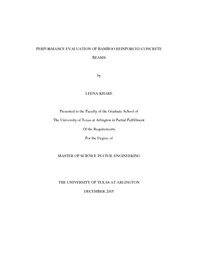| dc.contributor.author | Khare, Leena | en_US |
| dc.date.accessioned | 2007-08-23T01:56:17Z | |
| dc.date.available | 2007-08-23T01:56:17Z | |
| dc.date.issued | 2007-08-23T01:56:17Z | |
| dc.date.submitted | August 2005 | en_US |
| dc.identifier.other | DISS-1098 | en_US |
| dc.identifier.uri | http://hdl.handle.net/10106/210 | |
| dc.description.abstract | This study presents the evaluation of the feasibility of the use of bamboo as a potential reinforcement in concrete structural members. To achieve this objective a series of tensile tests on three types of bamboo Solid; Moso; and Tonkin; were conducted to obtain their constitutive relation. Also, four-point bending tests on concrete beams reinforced with bamboo were performed to identify their behavior compared to steel reinforced concrete members.
Tensile tests specimens were prepared by cutting the bamboo typically in 1/2 in (13 mm) wide strips of 9 to 12 in (228 mm to 305 mm) in length. In order to prevent crushing of the bamboo samples when placed in grips of the MTS machines end-tabs were epoxy glued to the bamboo samples. The results for the tensile tests which we performed indicated that the presence of nodes in Solid Bamboo samples did not affect the behavior. There was an indication that the fracture points of the tensile samples containing nodes occurred at the nodes, which was also verified in the beam tests. In general, samples failed in one or more of the following ways: (1) node failure; (2) end-tap failure; and (3) failure at the vicinity of the end-tap. Tensile tests of the three aforementioned bamboo types showed that the specimens with nodes behaved in a less ductile manner with higher strength than those without nodes.
Six four-point bending tests were conducted on 8 in x 20 in x 96 in (203 mm x 508 mm x 2429 mm) reinforced bamboo concrete beams. The variables used with test beams were two a/d ratios (1.5 and 2), four percentages of reinforcement (1%, 2%, 3% and 4%), and bamboo types (Moso and Solid). Tonkin bamboo was used for stirrups due to their highly ductile behavior observed during the tensile testing. Strain gages were applied at L/2 and L/4 of the beam and one on the stirrup at a distance'd' from the support for each beam. Coating was applied over strain gages to protect them from damage during casting. The test set-up consisted of placing the test beam under the Baldwin universal testing machine. A 200 k (890 kN) load cell was placed on the top of a rigid-beam, which was used to transfer the load from the hydraulic cylinder to the concrete beam through the two roller supports. Instrumentation consisted of a laser sensing device capable of measuring up to 4 in (102 mm) displacement with the accuracy of 1x10-4 in (0.00254 mm).White washing material was applied to the beam for crack detection during testing. The initiation and widening of cracks and their respective loads were recorded. The test results were compared with plain concrete and steel reinforced concrete beams behavior. In general, the test results indicated that bamboo reinforcement enhanced the load carrying capacity by approximately 250 % as compared to the initial crack load in the concrete beam. This study also showed that the ultimate load carrying capacity of bamboo reinforced concrete tested, on averaging all percent reinforcement, was about 35% of the equivalent reinforced steel concrete beams. The load carrying capacity of the Moso Bamboo reinforced beam was higher than that of Solid Bamboo reinforced beam. Also, the Solid bamboo reinforced beam in general deflected less than the Moso bamboo reinforced beam indicating that Moso bamboo behaved in a more ductile manner. Stirrups design provided small resistance to shear forces. Also, it was noticed that a direct relationship existed between the percentage of reinforcement and the load carrying capacity of the beams tested | en_US |
| dc.description.sponsorship | Abolmaali, Ali | en_US |
| dc.language.iso | EN | en_US |
| dc.publisher | Civil & Environmental Engineering | en_US |
| dc.title | Performance Evaluation Of Bamboo Reinforced Concrete Beams | en_US |
| dc.type | M.S. | en_US |
| dc.contributor.committeeChair | Abolmaali, Ali | en_US |
| dc.degree.department | Civil & Environmental Engineering | en_US |
| dc.degree.discipline | Civil & Environmental Engineering | en_US |
| dc.degree.grantor | University of Texas at Arlington | en_US |
| dc.degree.level | masters | en_US |
| dc.degree.name | M.S. | en_US |
| dc.identifier.externalLink | https://www.uta.edu/ra/real/editprofile.php?onlyview=1&pid=958 | |
| dc.identifier.externalLinkDescription | Link to Research Profiles | |

